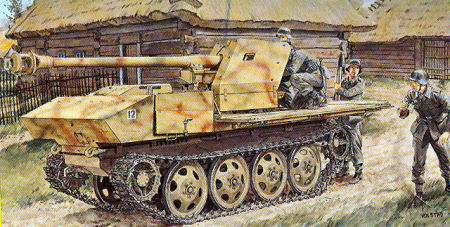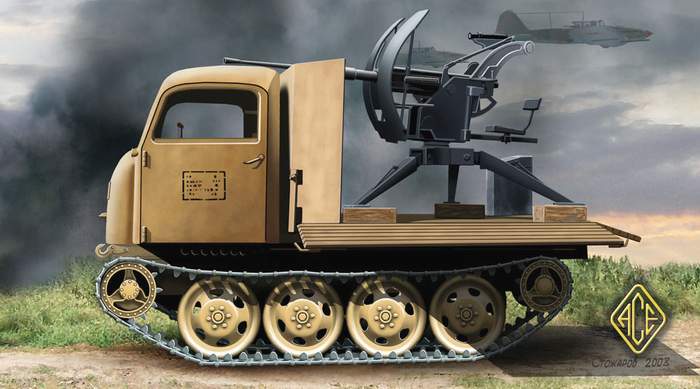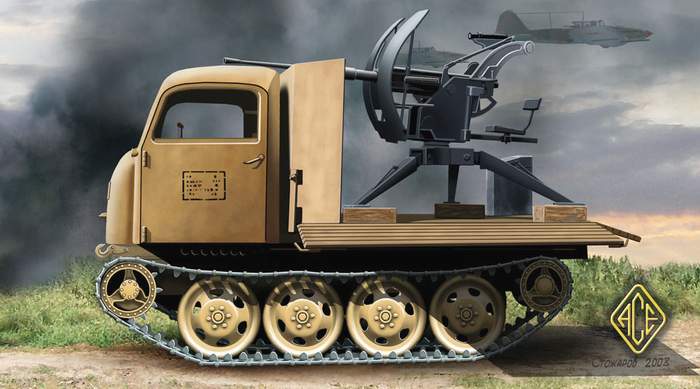


English Version
 |
Lorsque les allemands ont été confrontés aux dures conditions de déplacement sur le front de l'Est ils se mirent à étudier des solutions pour sortir de ce bourbier. En effet avant et juste après l'Hiver lorsque le temps n’est pas assez froid et le sol pas assez sec ou dur la boue envahit partout et empêche tout mouvement. Aussi après des moyens empiriques les allemands construisirent un engin spécifiquement adapté à pouvoir évoluer dans ces conditions la Ainsi est né le R. S. O.
Le RSO est un produit de la firme Steyr firme établie en Autriche. Je vais vous donner un bref aperçu de cette marque.
Historique de la marque
L marque de tire son nom de la ville éponyme de ce tir en octobre Autriche celle-ci est connue et réputée pour ses fabriques d’armement car en effet depuis le début du XVIIe siècle les usines de cette ville fournissent des armes aux armées impériales
Un ingénieur du non de Joseph Werndl fonde en avril 1864 la « Josef und Franz Werndl & Comp. Waffenfabrik und Sägemühle in Oberletten" ( Manufacture d'Armes et Scierie Josef et Franz Werndl & Compagnie d'Oberletten), qui se transformera plus tard en "Österreichische Waffenfabriksgesellschaft" (OEWG : Société austro-hongroise de production d'armes), puis en Steyr Werke AG et finalement Steyr-Daimler-Puch AG, dont Steyr Mannlicher est la filiale spécialisée dans l'armement léger.
Cette firme connaîtra un succès énorme avec le fameux fusil à verrou, le Repetier Gewher 1885, adopté par l'armée impériale autrichienne plus connu sous le nom de Mannlicher. En effet il avait été conçu par Ferdinand Ritter von Mannlicher, qui deviendra ingénieur en chef de la fabrique OEWG.Les fusils fabriqués par la firme furent utilisés par les armées autrichiennes et aussi furent exportés dans le monde entier . Le 29 avril 1889 voit le décès de Josef Werndl, mais les activités de l’entreprise continuent. Il est à noter que les armes Mannlicher sont très connues notamment c’est une carabine de ce type qui a servi à assassiner le président Kennedy en 1963
Durant la première guerre mondiale l’usine travaillera pour l’effort de guerre autrichien en produisant des moteurs d’avions et de l’armement. En 1919 suite au traité de Saint-Germain la firme se lance dans la fabrication d’automobiles et de camions étant donné que les fabrications d’armes avaient été interdites. Toutefois à compter de 1930 elle s’associe avec la société suisse Waffen Solothurn AG afin de construire de l’armement léger.
Suite à l'Anschluss 1938 elle redémarre la fabrique de véhicules pour le compte du III° Reich. A à la fin de la deuxième guerre mondiale il faut attendre 1950 pour que les usines puissent ressortir des armes de chasse. À la fin du XXe siècle elle met au point une arme d’assaut adopté par beaucoup d’armes étrangères. C’est le fusil STEYR AUG, arme assez futuriste qui a été notamment adoptée par l’armée australienne
les fabrications de camions et autobus reprennent peu à peu mais sans attendre sans atteindre de diffusion importante.
Le RSO. Pak40
Dans cet article je ne parlerai que du RSO qui a été transformé en plate forme d’armes. Antichar ou anti aérienne. ; Pour le canon voir l'article consacre à ce celui ci. Les modifications ont porté sur l’adaptation du plateau arrière en plate forme d’artillerie. En effet si le RSO était prévu dès l’origine pour tracter des pièces d’artillerie jusqu’à un calibre égal à 105 mm les ingénieurs se sont très vite demandés si cette plate-forme ne pouvait pas recevoir des armements. Divers essais furent effectués avec des 7.5cm Geb H36, des 10.5cm Geb H40 15cm IFH18/40 on y essaya même des 88 je vous laisse imaginer le spectacle avec cette arme
Deux types d’armes ont été adaptés sur le châssis la moins courante a été l’adaptation d’un canon de 20 mm automatiques anti aérien Flak 38.Pour ce faire la cabine tôlée a été conservée.
 |
Seulement 12 engins furent équipés avec ce canon anti aérien
.la modification majeure effectuée avec les systèmes d’armes a été faite avec l’adaptation du canon antichar Pak 40 sur ce châssis
Pour ce faire il a fallu modifier assez radicalement la silhouette de l’ engin. En effet tout a été arasé au niveau du châssis pour y adapter un plateau comprenant sur la partie avant le poste de conduite à l’air libre et à l’arrière le plateau pouvant supporter le canon de 75 mm
Les essais débutèrent en août 1943 lorsque les ingénieurs de Steyr signalèrent au Waffenamt (l’équivalent de notre STAT ou Ordnance département US ) qu’un canon antichar en l’occurrence le PaK 40 pouvait être monté sur la plate-forme arrière 15 engins furent commandés pour tests qui se terminèrent le 30/09/1943 . Ces engins furent envoyés en URSS pour combattre au sein des 7751°Panzer Jaëger Abteilung de la 16° Arme et du 752 ° Panzer Jaëger Abteilung de la 18° Armée. Le système d’armes présenté à Hitler fut tout de suite accepté par celui-ci car il voyait en lui un système d’armes peu coûteux qui combinait différentes qualités capacités antichar importante manoeuvrabilité hors du commun avec une forte possibilité d’emport de munitions.
Les plans prévoyaient une production de 50 engin mensuels En janvier 1944 le programme de production fut établi de façon définitive le RSO devait pouvoir sortir au début à 50 exemplaires mensuel pour arriver au mois de juillet à 400 exemplaires. Toutefois seulement 60 engin furent construits .Ces engins ne furent pas du tout appréciés par leurs équipages qui les affublent du surnom de cercueil ambulant en détournant les abréviations officielles (Rollender Sarg Ost)
. En effet aucune protection n’était possible pour l’équipage de pièce. De plus la lenteur de l’engin en faisait une cible idéale pour les chasseurs de chars adverses et enfin sa haute silhouette ne permettait pas un camouflage rapide et aisé
La composition de l unité de basé était la suivante 3 RSO Pak 40 un ravitailleur et le commandant sur une Kubelwagen
Description de l’engin
La cabine fermée était remplacée par une cabine « torpédo » légèrement armée Le plateau arrière accueillait le système d arme. Les ridelles en bois pouvaient se rabattre offrant ainsi une plate-forme un peu plus grande Lorsque le véhicule se déplaçait il fut prévu de lui adapter une bâche couvrant la totalité de la plate-forme arrière et protégeant l’équipe de pièce des intempéries .l’équipe de pièce était de quatre hommes .
Vous trouverez toutes les spécificités du Pak 40 dans l’article consacré à celui-ci
Caractéristiques.
Constructeur
Steyr
Poids 5.3 T
Equipage 4
Longueur 4.57m
Largeur 1.99
Hauteur 2.6m
Moteur Steyr V8 type 85 PS 3.5 litres
BAV 4 avant 1 arrière
Vitesse 17.2 km/h
Autonomie 250 Kms
Armement 1x 7.5cm PaK40/4/46
Azimut 30° de chaque cote
Site -5°+22°
Voir Aussi See Also
Raupenschlepper .7.5cm Pak40/4 auf Raupenschlepper Ost (Sf) Russie
Raupenschlepper .7.5cm Pak40/4 auf Raupenschlepper Ost (Sf)
Raupenschlepper .7.5cm Pak40/4 auf Raupenschlepper Ost (Sf)
Raupenschlepper Gebirgsschlepper Ost Arlon
Raupenschlepper Ost 01
Canon Anti Char PaK 40 Draguignan
When the Germans were confronted with the harsh conditions of circulation on the East front they began to explore ways to break out of this quagmire. Indeed before and just winter when the weather is not cold the soil is not enough dry and the mud invades everywhere and prevents any movement. Also after empirical ways Germans built a vehicle specifically adapted to evolve in such circumstancesThus was born the R. S. O.
The RSO is a product of the firm Steyr firm established in Austria. Let me give you a brief overview of that mark.
History of the mark
The firm takes its name from the eponymous town of Steyr in Austria it is known is known for its weapons factories that in effect since the beginning of the XVIIst factories of this town supply arms to the imperial armies
An engineer Joseph Werndl found in April 1864 the " Josef und Franz Werndl & Comp. Waffenfabrik und Sägemühle in Oberletten, which was later transformed into" Österreichische Waffenfabriksgesellschaft "(OEWG: Austro-Hungarian Society weapons production), then Steyr Werke AG and finally Steyr-Daimler-Puch AG, which is the Steyr Mannlicher subsidiary specializing in Light weapons.
This company with the famous gun lock, Repetier Gewher 1885, was adopted by the imperial army Austrian more known as Mannlicher has an enormous success. In fact it was designed by Ferdinand Ritter von Mannlicher, which will become chief engineer of the OEWG. Ribles manufactured by the company were used by the Austrian armed and were also exported worldwide. On April 29th 1889 saw the death of Josef Werndl, but the company's activities continue. It should be noted that the weapons are very well known Mannlicher particular it is a rifle of this type that has been used to assassinate President Kennedy in 1963
During the WW1 the factory work for the war effort by producing Austrian aircraft engines and armaments. In 1919 in result of to the Treaty of Saint-Germain, firm start in the manufacture of cars and trucks ( weapons manufacturing had been banned. ) But beginning in 1930 she joined with the Swiss company Waffen Solothurn AG to build Light weapons.
Following 1938 and the Anschluss it will restart the factory vehicles for the Third Reich. At the end of the Second World War we must wait for 1950 that the plants can emerge from hunting weapons. In the late twentieth century it is developing a weapon adopted by many foreign weapons. The STEYR AUG rifle, rather futuristic weapon, which was particularly taken by the Australian Army
Manufacturing of trucks and buses resumed gradually but without reaching an important. dissemination
The RSO. Pak40
In this article I will speak only about RSO that has been transformed into a platform for the Antitank or antiaricraft weapon ; For the gun see here. The changes have focused on adapting on the rear platform artillery. Indeed, if the RSO was planned from the outset to tow artillery pieces to a size equal to 105 mm engineers were quickly questioned whether this platform could not receive arms. Various tests were performed with 7.5cm Geb H36, H40 Geb 10.5cm there 15cm IFH18/40 even tried 88 I let you imagine the spectacle with this weapon
Two types of weapons have been adapted on the chassis less common was the adaptation of a 20 mm cannon automatic air anti Flak 38. Fot this the steel-iron cabin has been preserved.
 |
Only 12 machines were equipped with anti-air gun
But the major modification was made with the adaptation of Pak 40 anti-tank gun on the chassis
To do this it was necessary to change fairly radically the silhouette of the vehicle. Indeed cabin will be level for the adaptation of the rear comprtiment
So the party before with the driver is open air and on the back we found the 75 mm gun
The tests began in August 1943 when engineers Steyr pointed to Waffenamt (the equivalent of our STAT or US Ordnance Department) an antitank gun in this case the PaK 40 could be mounted on the rear platform of the vehicle 15 ordered to test that ended on september 30th 1943. These vehicles were sent to the USSR to fight with the 7751 ° Panzer Jaëger Abteilung of 16 ° Army and 752 ° Panzer Jaëger Abteilung of 18 ° Army. The weapons system was présented to Hitler and immediately accepted by the latter because he saw him as a weapons system inexpensive which combined capacity antitank important manoeuvrability out of the ordinary with a strong possibility of carrying ammunition.
The plans included a production of 50 vehicles/ monthly In January 1944 the production program was established permanently on RSO should be able to go out at the beginning to 50 copies monthly to arrive in July to 400 copies. But only 60 were built . These weapon systems were not at all appreciated by their crews who affublent's nickname coffin itinerant diverting the official abbreviation (Rollender Sarg Ost)
. Indeed no protection was possible for the team. In addition to the slowness of the machine made a perfect target for enemy and his high outline could not bring and quick and easy camouflage
The composition of the unit was was3 Pak RSO 40 a tanker and the commander on a Kubelwagen
Description of the equipment
The closed cabin was replaced by a " torpédo cabin" lightly armed The rear shelf hosted the weapon system. The wooden racks could rely providing a platform a little larger When the vehicle was movin it was planned to adapt a tarp covering the whole of the platform at the stern and protecting the team of the bad weather. The team was of 4 men.
You will find all the specifics of the Pak 40 in the article devoted to it
Specifications.
Manufacturer Steyr
Weight 5.3 T
Crew 4
Length 4.57m
Width 1.99
Height 2.6m
Steyr V8 Engine type 3.5 litre 85 PS
BAV 4 before 1 back
Speed 17.2 km / h
Autonomy 250 Kms
Weaponry 1x 7.5cm PaK40/4/46
Azimut 30 degrees on each side
Site +22 ° -5 °
Voir Aussi See Also
Raupenschlepper .7.5cm Pak40/4 auf Raupenschlepper Ost (Sf) Russie
Raupenschlepper .7.5cm Pak40/4 auf Raupenschlepper Ost (Sf)
Raupenschlepper .7.5cm Pak40/4 auf Raupenschlepper Ost (Sf)
Raupenschlepper Gebirgsschlepper Ost Arlon
Raupenschlepper Ost 01
Raupenschlepper Ost Type 01 Sinsheim
RaupenschlepperOst -2 (Sf) Sinsheim
Canon Anti Char PaK 40 Draguignan